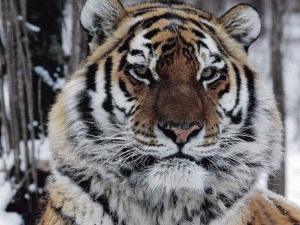
Beautiful isn’t he? 500 pounds of feline power and grace.
The Amur Tiger can leap 25 feet horizontally . . ten feet straight up! Ten feet long from tail to nose, these endangered animals live in a unique swath of land in Russia east of China and west of the Pacific Ocean (not Siberia). Protected by stringent laws and enforcement agencies, the Amur Tiger is the largest living specimen of the cat family. Illegally hunted by ruthless poachers, an Amur Tiger, dead or alive, can bring tens of thousands of dollars in bounty.
One such poacher was Vladimir Markov. In 1997 he met a violent end by the very tiger he had previously shot and wounded, but had not killed. That outcome doesn’t sound so unusual. Poaching in this primeval section of Russia is dangerous and the prey is vicious. However, Markov’s death was remarkable because of the unexpected behavior of the tiger.
Markov’s aim was off, but the tiger’s was not. The tiger escaped Markov’s rifle, but found his way to Markov’s home, many miles away. There the tiger destroyed anything with Markov’s scent and waited patiently for Markov’s return. For up to 48 hours he waited, until Markov returned home unaware the hunter had become the hunted. The Tiger made short work of Markov, killed him, carried him off and ate him. Some would say Markov met a well-deserved end. Perhaps he did. It was horrible nonetheless. The true story of Markov and the hunt for the spiteful tiger is told by John Valliant in The Tiger: A True Story of Vengeance and Survival.
However, the fact that a tiger could behave in human fashion with calculated, pre-meditated and deliberate revenge seems to defy reason. Can animals formulate a strategic plan and carry out a fatal pay back scheme holding that plan in mind for 2 days? Apparently so.
Perhaps the better question might be whether humans act with higher level thinking when we exact revenge on someone who has violated our expectations. Neuroscience tells us that vengeance and retaliation are physiological responses rather than thoughtful expressions of self-preservation. Amazingly, revenge generates a neuro-chemical which is far more physiologically satisfying than reconciliation. Revenge is more akin to animal instinct, than human reason. It is literally against our biological nature to work toward peace.
If we fancy ourselves superior to animals because of our capacity to reason, giving in to “getting even” reveals our most basic animal behavior. Further, neuroscience informs us that in stressful situations our thought processes are less than two per cent rational. Instead, in conflict we seldom act as thinking human beings. We rely on instinct and learned behaviors (many of which are less than mature) in conflict settings. We may not be able to leap 25 feet, but we certainly can carry out our revenge motivations with a flair similar to the ruthless Amur tiger.
If our behaviors in conflict are largely subconscious (and they are), perhaps we can relearn our conflict responses and bring them into the conscious mind to achieve better results. After all, the tiger that got his vengeance on Markov was himself hunted down and killed. Living by the sword (or claws and fangs) indeed leads to death by similar means.


Greetings;
Many thanks for your really interesting take on my book. It adds a lot to the conversation (not to mention my own understanding of these impulses).
However, I would be grateful if you could correct this error ASAP:
“The Amur Tiger can leap 25 feet . . . straight up!”
Tigers can jump vertically ten ft. or so.
they leap -horizontally- 20-30ft.
Once this is corrected I would like very much to link this article to my website, FB fanpage and via Twitter (johnvaillant)
thanks,
John
Thanks. We are happy to make that correction immediately. Best wishes on the promotion of this great book.
Thanks for the interesting take on the relationship between rationality & emotions. I did want to note that I was swayed by the author’s suggestion that the “Czar” of the forest actually operates on a higher level of morality than many humans achieve. Thanks for a thought-provoking article.
I was at a reading by John Vaillant of his excellent new book “Conflict Tiger” at Bolen Books in Victoria, BC recently.
I had the opportunity to rgale John with the true story of a vengeful wild elephant I enountered in the (then) small town of Amparai, in the eastern part of Sri Lanka back in December 1973 when I served as a Voluntary Service Overseas (VSO teacher on the Island.
This elephant loved nothing more than to raid plantain trees in people’s back gardens. Most locals turned a blind eye and kept out of its way, and it didn’t physically harm anyone. But one upset resident began throwing stones at the elephant to scare it away. The elephant first retaliated by giving chase when it saw him bicycling home from work in the evenings. Late one night, it went a stage further – it came to his bungalow, shoved the corrugated metal roof aside, reached inside with its trunk – and smashed the fellow’s bedroom furniture into smithereens!
Fortunately the unlucky homeowner, abruptly woken by the dreadful commotion (imagine the screech of torn metal above your head in the dark combined with an angry elephant trumpeting at extremely close quarters!) managed to flee the scene just in time!
I think the fellow left the area soon after, and the elephant – no doubt having had its satisfying revenge-generated neuro-chemical rush – reverted back to peaceful plantain-raiding….
[…] smell of revenge?” Axlerod, says that’s the best way to lose the exchange. (See: Revenge: A Subhuman Instinct) Playing out this methodology consistently and flexibly provides the greatest guarantee that a […]